| Availability: | |
|---|---|
| Quantity: | |
Introduction:
JGK Series Copper Cable Lugs is used for connection of copper cable with copper end of electrical equipment in low voltage.This terminal connectors is a fundamental and critical
part of electrical systems, designed to terminate, connect, and secure electrical cables to various apparatus like terminals, busbars, or other lugs.
Material:Cu≥99.9%
Surface:tin plated
Drawings:
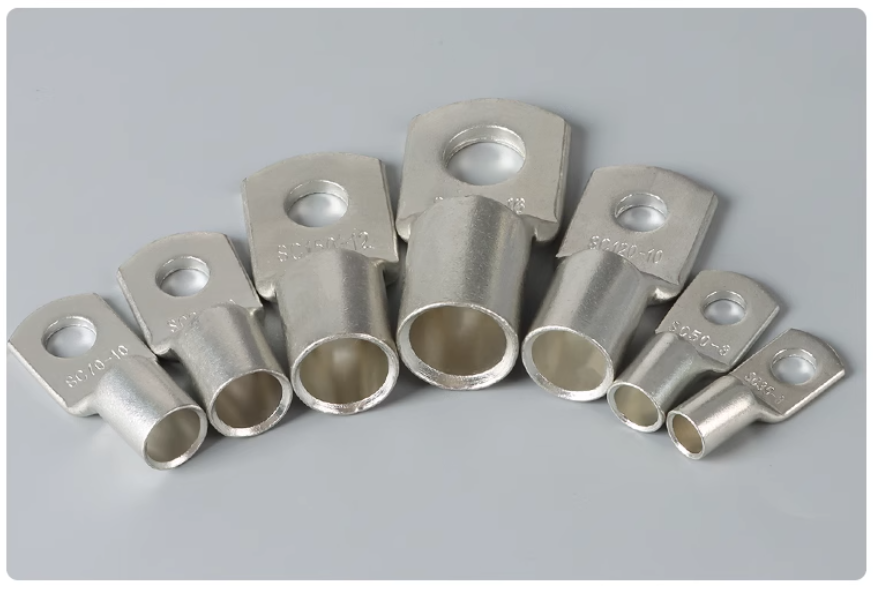
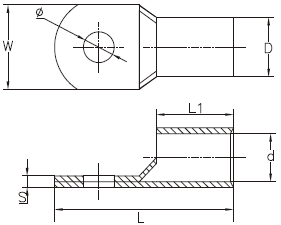
Speficications:
Type | φ±0.5 | D±0.5 | d±0.5 | L±2 | L1±2 | S±0.2 | W±1.5 |
SC(JGK)-6 | φ6.5 | 6 | 4.8 | 24.5 | 8 | 1.2 | 9 |
SC(JGK)-6 | φ8.5 | 6 | 4.8 | 24.5 | 8 | 1.2 | 9 |
SC(JGK)-10 | φ6.5 | 6.7 | 5.7 | 25 | 10 | 1 | 11.5 |
SC(JGK)-10 | φ8.5 | 6.7 | 5.7 | 25 | 10 | 1 | 11.5 |
SC(JGK)-16 | φ6.5,φ8.5 | 8 | 6.4 | 31 | 11 | 1.6 | 11.8 |
SC(JGK)-16 | φ10.5 | 8 | 6.4 | 31 | 11 | 1.6 | 14 |
SC(JGK)-25 | φ6.5,φ8.5,φ10.5 | 9 | 7.2 | 33 | 13 | 1.8 | 13 |
SC(JGK)-35 | φ6.5,φ8.5,φ10.5 | 10.5 | 8.5 | 38 | 15.5 | 2 | 15.5 |
SC(JGK)-35 | φ12.5 | 10.5 | 8.5 | 38 | 15.5 | 2 | 16.5 |
SC(JGK)-50 | φ8.5,φ10.5,φ12.5 | 12.5 | 10.2 | 45 | 17 | 2.3 | 18.3 |
SC(JGK)-70 | φ8.5,φ10.5,φ12.5 | 14.5 | 11.5 | 48 | 18 | 3 | 21 |
SC(JGK)-95 | φ8.5,φ10.5,φ12.5,φ14.5 | 17 | 14 | 55 | 22 | 3 | 25 |
SC(JGK)-120 | φ10.5,φ12.5 | 19 | 15 | 64 | 22 | 3.5 | 27.5 |
SC(JGK)-150 | φ10.5,φ12.5,φ14.5,φ16.5 | 21 | 17 | 68 | 26 | 4 | 31 |
SC(JGK)-185 | φ12.5,φ14.5,φ16.5 | 23 | 19 | 75 | 28 | 4 | 33.5 |
SC(JGK)-240 | φ12.5,φ14.5,φ16.5 | 26 | 21 | 89 | 32 | 5 | 38 |
SC(JGK)-300 | φ16.5 | 30 | 24 | 99 | 37 | 6 | 44 |
SC(JGK)-400 | φ16.5 | 31.9 | 25.7 | 110 | 41 | 6 | 47 |
SC(JGK)-500 | φ20.5 | 38 | 30 | 116 | 42 | 8 | 55 |
SC(JGK)-630 | φ20.5 | 45 | 36.3 | 135 | 53.5 | 8.6 | 65 |
Performance:
The performance of this tubular cable lugs is defined by its material properties and electrical characteristics, which ensure reliability and safety:
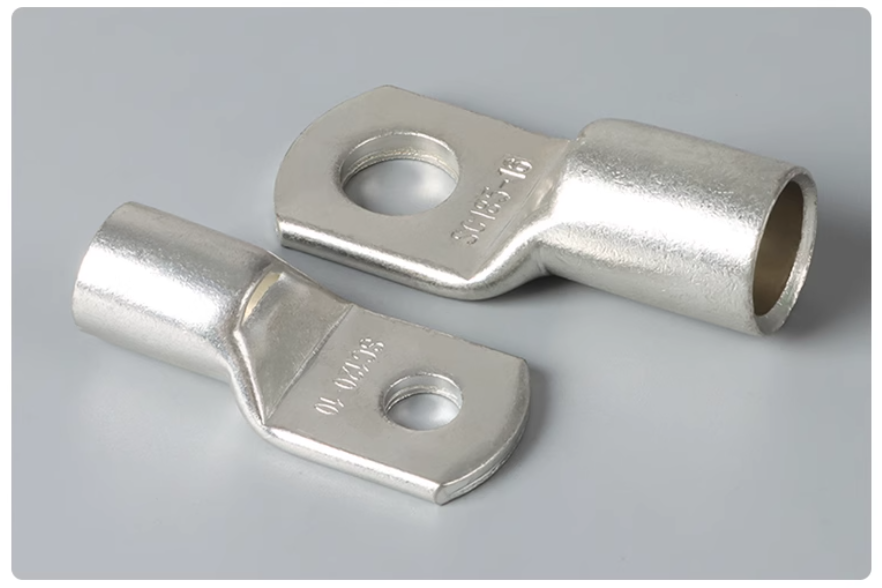
Material: Fabricated from high-purity electrolytic copper. This provides excellent electrical conductivity, minimizing resistance and power loss (I²R losses) at the connection point, which is crucial for efficient power transmission.
Current Carrying Capacity: Rated to handle significant electrical current loads. Its robust copper construction ensures it can manage the thermal stresses associated with high currents without performance degradation.
Corrosion Resistance: Copper offers inherent resistance to corrosion. This is often enhanced by a plating (such as tin, which may not be visually distinct in the image), which further protects against oxidation and environmental factors, ensuring long-term stability and a low-resistance surface.
Temperature Rating: Designed to withstand elevated temperatures generated by electrical current flow during normal operation and short-circuit conditions without deforming or failing.
Mechanical Strength: The copper terminals provides a physically robust and secure connection point, resistant to vibration and mechanical stress, which helps maintain integrity over time.
Electrical Safety: By creating a secure, low-resistance connection, it significantly reduces the risk of dangerous hot spots, arcing, and potential fire hazards that can occur with loose or inadequate connections.
Process:
The processes involved include its manufacturing and its correct application in the field:
Manufacturing Process: Typically produced through precision cold forming or machining from solid copper bar stock. This process ensures dimensional accuracy and a smooth, flawless surface.
The barrel (or crimp tube) is formed to a specific inner diameter to match standard cable sizes.
The tongue (or palm) is stamped or machined flat with a precision-drilled hole for a bolt. The "SC" designation often implies a "Straight Barrel" style with a single hole.
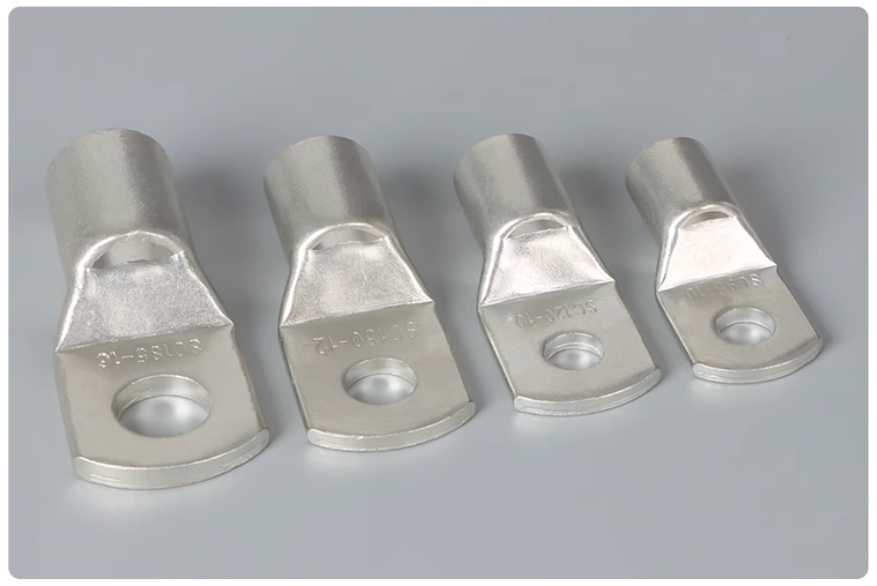
Application (Crimping) Process: Proper installation is vital for performance.
The insulation is stripped from the cable end to expose the conductor.
The bare conductor is fully inserted into the lug's barrel.
A dedicated, calibrated crimping tool (e.g., a hydraulic, mechanical, or pneumatic crimper) is used to compress the barrel onto the conductor. This creates a permanent, cold-welded, gas-tight connection. This connection prevents moisture and oxygen from entering, preventing corrosion within the joint itself.
Mounting: The lug is then secured to its destination (e.g., a terminal blocks) by inserting a bolt through the hole in the tongue and tightening it to the specified torque.
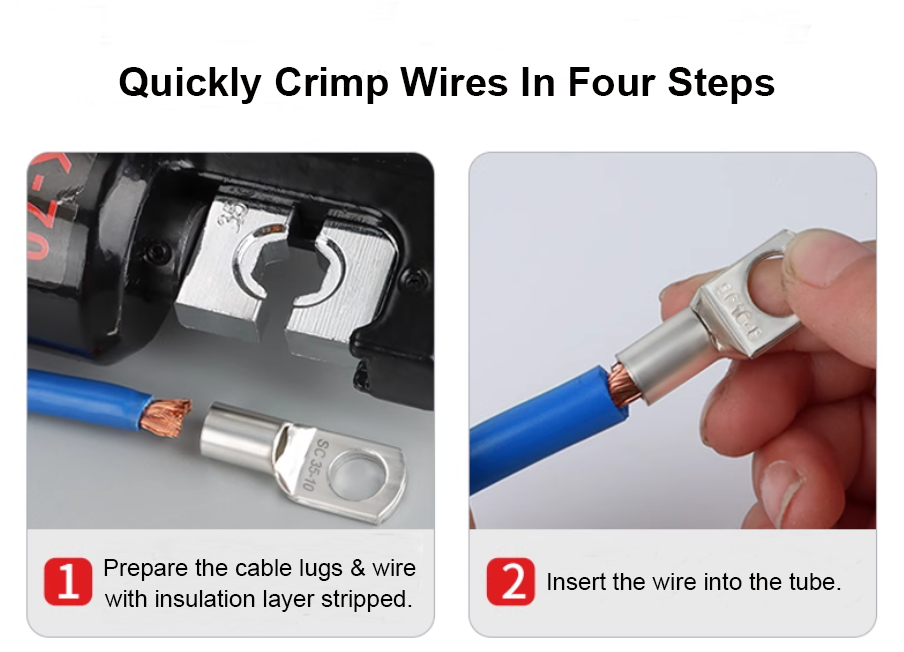
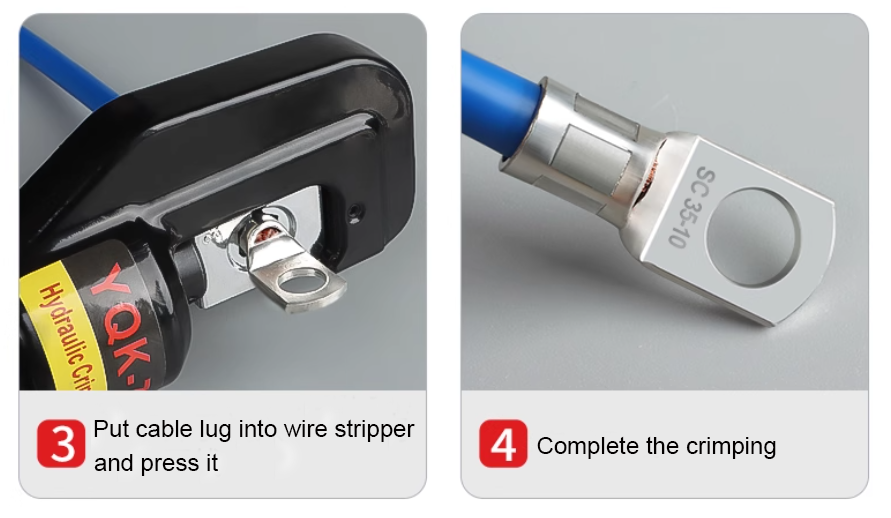
Applications:
Copper Cable Lugs (wiring terminals) are ubiquitous in electrical engineering due to their reliability. Key application areas include:
Electrical Power Systems: Used extensively in switchgear, panel boards (distribution boards), circuit breakers, transformers, and motor control centers.
Industrial Applications: For providing secure power connections in heavy industrial machinery, manufacturing equipment, and assembly lines.
Renewable Energy Installations: Essential components in solar photovoltaic (PV) farms (combiner boxes, inverters) and wind turbine electrical systems for connecting large cables.
Power Distribution and Transmission: Found in both overhead power lines and underground cable networks for splicing and terminating cables.
Construction and Infrastructure: Used in building electrical systems for main power distribution, sub-panels, and high-power circuits.

Introduction:
JGK Series Copper Cable Lugs is used for connection of copper cable with copper end of electrical equipment in low voltage.This terminal connectors is a fundamental and critical
part of electrical systems, designed to terminate, connect, and secure electrical cables to various apparatus like terminals, busbars, or other lugs.
Material:Cu≥99.9%
Surface:tin plated
Drawings:


Speficications:
Type | φ±0.5 | D±0.5 | d±0.5 | L±2 | L1±2 | S±0.2 | W±1.5 |
SC(JGK)-6 | φ6.5 | 6 | 4.8 | 24.5 | 8 | 1.2 | 9 |
SC(JGK)-6 | φ8.5 | 6 | 4.8 | 24.5 | 8 | 1.2 | 9 |
SC(JGK)-10 | φ6.5 | 6.7 | 5.7 | 25 | 10 | 1 | 11.5 |
SC(JGK)-10 | φ8.5 | 6.7 | 5.7 | 25 | 10 | 1 | 11.5 |
SC(JGK)-16 | φ6.5,φ8.5 | 8 | 6.4 | 31 | 11 | 1.6 | 11.8 |
SC(JGK)-16 | φ10.5 | 8 | 6.4 | 31 | 11 | 1.6 | 14 |
SC(JGK)-25 | φ6.5,φ8.5,φ10.5 | 9 | 7.2 | 33 | 13 | 1.8 | 13 |
SC(JGK)-35 | φ6.5,φ8.5,φ10.5 | 10.5 | 8.5 | 38 | 15.5 | 2 | 15.5 |
SC(JGK)-35 | φ12.5 | 10.5 | 8.5 | 38 | 15.5 | 2 | 16.5 |
SC(JGK)-50 | φ8.5,φ10.5,φ12.5 | 12.5 | 10.2 | 45 | 17 | 2.3 | 18.3 |
SC(JGK)-70 | φ8.5,φ10.5,φ12.5 | 14.5 | 11.5 | 48 | 18 | 3 | 21 |
SC(JGK)-95 | φ8.5,φ10.5,φ12.5,φ14.5 | 17 | 14 | 55 | 22 | 3 | 25 |
SC(JGK)-120 | φ10.5,φ12.5 | 19 | 15 | 64 | 22 | 3.5 | 27.5 |
SC(JGK)-150 | φ10.5,φ12.5,φ14.5,φ16.5 | 21 | 17 | 68 | 26 | 4 | 31 |
SC(JGK)-185 | φ12.5,φ14.5,φ16.5 | 23 | 19 | 75 | 28 | 4 | 33.5 |
SC(JGK)-240 | φ12.5,φ14.5,φ16.5 | 26 | 21 | 89 | 32 | 5 | 38 |
SC(JGK)-300 | φ16.5 | 30 | 24 | 99 | 37 | 6 | 44 |
SC(JGK)-400 | φ16.5 | 31.9 | 25.7 | 110 | 41 | 6 | 47 |
SC(JGK)-500 | φ20.5 | 38 | 30 | 116 | 42 | 8 | 55 |
SC(JGK)-630 | φ20.5 | 45 | 36.3 | 135 | 53.5 | 8.6 | 65 |
Performance:
The performance of this tubular cable lugs is defined by its material properties and electrical characteristics, which ensure reliability and safety:

Material: Fabricated from high-purity electrolytic copper. This provides excellent electrical conductivity, minimizing resistance and power loss (I²R losses) at the connection point, which is crucial for efficient power transmission.
Current Carrying Capacity: Rated to handle significant electrical current loads. Its robust copper construction ensures it can manage the thermal stresses associated with high currents without performance degradation.
Corrosion Resistance: Copper offers inherent resistance to corrosion. This is often enhanced by a plating (such as tin, which may not be visually distinct in the image), which further protects against oxidation and environmental factors, ensuring long-term stability and a low-resistance surface.
Temperature Rating: Designed to withstand elevated temperatures generated by electrical current flow during normal operation and short-circuit conditions without deforming or failing.
Mechanical Strength: The copper terminals provides a physically robust and secure connection point, resistant to vibration and mechanical stress, which helps maintain integrity over time.
Electrical Safety: By creating a secure, low-resistance connection, it significantly reduces the risk of dangerous hot spots, arcing, and potential fire hazards that can occur with loose or inadequate connections.
Process:
The processes involved include its manufacturing and its correct application in the field:
Manufacturing Process: Typically produced through precision cold forming or machining from solid copper bar stock. This process ensures dimensional accuracy and a smooth, flawless surface.
The barrel (or crimp tube) is formed to a specific inner diameter to match standard cable sizes.
The tongue (or palm) is stamped or machined flat with a precision-drilled hole for a bolt. The "SC" designation often implies a "Straight Barrel" style with a single hole.

Application (Crimping) Process: Proper installation is vital for performance.
The insulation is stripped from the cable end to expose the conductor.
The bare conductor is fully inserted into the lug's barrel.
A dedicated, calibrated crimping tool (e.g., a hydraulic, mechanical, or pneumatic crimper) is used to compress the barrel onto the conductor. This creates a permanent, cold-welded, gas-tight connection. This connection prevents moisture and oxygen from entering, preventing corrosion within the joint itself.
Mounting: The lug is then secured to its destination (e.g., a terminal blocks) by inserting a bolt through the hole in the tongue and tightening it to the specified torque.


Applications:
Copper Cable Lugs (wiring terminals) are ubiquitous in electrical engineering due to their reliability. Key application areas include:
Electrical Power Systems: Used extensively in switchgear, panel boards (distribution boards), circuit breakers, transformers, and motor control centers.
Industrial Applications: For providing secure power connections in heavy industrial machinery, manufacturing equipment, and assembly lines.
Renewable Energy Installations: Essential components in solar photovoltaic (PV) farms (combiner boxes, inverters) and wind turbine electrical systems for connecting large cables.
Power Distribution and Transmission: Found in both overhead power lines and underground cable networks for splicing and terminating cables.
Construction and Infrastructure: Used in building electrical systems for main power distribution, sub-panels, and high-power circuits.
